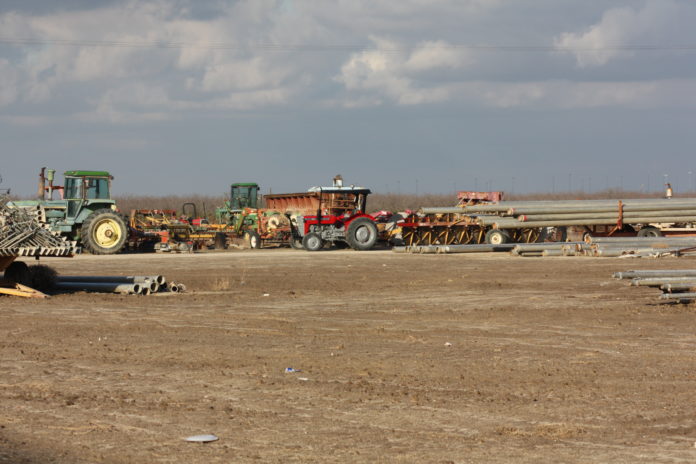 The Tulare Irrigation District held its board of directors meeting on Tuesday, March 9, 2021 remotely by Zoom. I still like Zoom and now have reason to suspect it’s better than I thought. But I’m going to do a little research before I spill the beans on this exciting new revelation that only matters to a handful of people who attend district meetings remotely without functioning cameras and microphones on their computer.
The Tulare Irrigation District held its board of directors meeting on Tuesday, March 9, 2021 remotely by Zoom. I still like Zoom and now have reason to suspect it’s better than I thought. But I’m going to do a little research before I spill the beans on this exciting new revelation that only matters to a handful of people who attend district meetings remotely without functioning cameras and microphones on their computer.
Chairman Dave Bixler called the meeting to order at the scheduled 9:00am start time and General Manager Aaron Fukuda said there would be a slight change in the original agenda.
Water Report
Water Master Marco Crenshaw gave what he called a “dry” report. There’s supposed to be a storm hit tomorrow but nothing tracking after that for another couple of weeks. The snow course in the Kaweah River watershed shows 40 percent and if the rest of the season is normal it might yield only a month’s worth of irrigation in TID. The San Joaquin River is a little better at 60 percent. Crenshaw said in 1991 conditions were very similar to this year and there was a Miracle March with late storms yielding a normal year.
TID has 1,500 a/f of carryover in Millerton Lake and due to the low levels that supply will most likely go to Lindsay Strathmore ID in a decades long agreement to backstop that district in a dry year. There was some interesting details on a water agreement with the City of Visalia. TID sends the City water and the City has tertiary treated water it sends back to the system in wet years. It was asked if that water is recharged but the State Board won’t let you recharge treated water. However it is just fine for this water to soak in as channel loss. How about that?
Groundwater
Fukuda and Crenshaw gave the board the results of the depth to groundwater study. TID compares spring to spring and fall to fall. In the past 100 years the average depth of groundwater in TID has gone from 20 feet to 180 feet. Fukuda said with SGMA in mind some of the actions in the Groundwater Sustainability Plan will have to be rolled out sooner than expected. Geoff Vanden Heuvel of the Milk Producers Council said farming use is still operating as if SGMA isn’t in play. He said in the Tule Subbasin the GSA has started some transitional pumping and everyone knows what to expect. He said the Mid Kaweah Subbasin is in better shape with surface supplies than its neighbors but the Greater Kaweah Subbasin needs to realize it is doing no one any favors to put off transition pumping and cause a steep pumping decline all at once. Director Dave Martin said he agrees with Vanden Heuvel saying the amount of residential development between the Cities of Visalia and Tulare is growing as well and there needs to be a realization you can’t eat asphalt and concrete.
O&M
Superintendent Wayne Fox reported the dry conditions have allowed for more time to get extra maintenance on the system. He said the district’s ditches and infrastructure is in good shape for Crenshaw to run a bunch of water down when it shows up. Points on for Fox’s positive attitude. One of the benefits of the current less than desirable hydrological condition is the opportunity to prepare for flood control. There are ditch banks that needed increased height to handle flood flows when they come and they will someday.
Treasurer’s Report
Controller Kathi Artis gave the treasurer’s report which includes a review of financial statements, approval of the bills and a ratification of investment policy. The Local Agency Investment Fund has a declining interest rate. The LAIF is an interesting species of investment. If I understand correctly it provides for greater liquidity but at a lower interest rate. As I daydream about what I’ll do with my lottery winnings I don’t always take that relationship between yield and liquidity into account. Fukuda said there will be some extra legal expenses coming up but I didn’t catch which trial in particular. Fukuda also said the district had to write a check against some grant funds and the grant funds finally showed up, so all is well. The board approved all the things Artis presented.
Fukuda said he and Artis go over the district’s investment policy annually and it is the same as past years. The policy sets limits on what the district can and cannot invest in. The board approved.
Engineering Report
TID Engineer Jeremy Barroll gave his report saying his display of brute force and raging hostility prevailed in a dispute with a developer. Wait, I heard wrong, I’m sorry, turns out he was able to negotiate an agreement with a developer using his considerable charm. That was that. Good job.
Management & Staff Reports
So far there have been 15 TID employees to receive Sino-virus shots. Fukuda said the goal was to have enough staff prepared to handle things during the irrigation season.
SGMA
The Kaweah Subbasin GSAs have awarded Montgomery & Associates the MODFLOW Groundwater Model contract. Fukuda said the cost was $150,000 but the grant only paid $149,999.94 and he just decided to kick in the extra six cents out of his pocket.
The Kaweah Subbasin also won a $3.9 million Prop 68 Grant award. He said this is the first round of this type of grant and it might take a little longer than usual to get paid but it is still a good win for the Kaweah folks. There is still $50 million left in Prop 68 so the next round will be competitive.
The Mid Kaweah GSA is conducting a general manager search and a management agreement with TID is in the works.
The San Joaquin Valley Water Blueprint has a need for wide range input. But not all the folks that are welcome to the table are willing to step up. But you add the panache of holding talks facilitated by Stanford and you get the SJV Water Action Program. Fukuda has been asked to provide his unique brand of adult supervision to this effort. Good for him.
Priorities for 2021 include getting the monitoring in place and a water rights workshop later this month. The State Board has thrown down a gauntlet in the form of a draft paper on adjusting water rights in light of the looming climate change crisis that will cause the earth to spin backwards. A workshop will be held presumably to remind folks that a right isn’t something the government provides or grants, it merely acknowledges and defends rights.
Friant
The motor rewind at the Jones Pumping Plant in Tracy is a multi-million dollar project and Friant pays a share. Director Mike Thomas said if you can get a tour of the plant you should do so. I agree I’ve had two tours and it is incredible. Anyway, TID’s share of Friant’s share is in the hundreds of thousands of dollars. The pumps were designed and built to run, the motors and shafts are three stories tall. If you constantly turn them on and off they wear out faster.
Senator Melissa Hurtado has reintroduced SB 559 which includes funding for repairs of the Friant Kern Canal, the California Aqueduct and the San Luis Delta Mendota Canal.
Repairs on the FKC includes funding for new pumpstations but the way to deal with this has yet to be worked out. The agreement between the districts and the FWA is for adjustments but not “betterment” of the pumpstations. All clear? It has something to do with how head pressure is adjusted coming out of the canal. Director Rick Borges is the TID representative to FWA and he said the description of the adjustments is the question at hand.
Fukuda next spoke about how much it costs and how to make the payments. The FKC repair takes $50 million off the top. There are additional Jones Pumps and SLDM Canal costs and SGMA projects to figure in. Like the Kaweah Delta Water Conservation District the sale of the power plant at Lake Kaweah gives a one time financial boost but also removes a source of income.
Fukuda put up a chart showing some of the scenarios that could happen to TID’s coffers/cash reserves over the course of the Jones rewind and the FKC repairs. I got to say Fukuda’s a pretty good accountant and good with charts. I almost understood it.
At this month’s FWA meeting an agreement is expected to be presented to the board establishing the authority and roles of the US Bureau of Reclamation and FWA in repairing the canal. The Bureau puts up $250 million and $86 million is non-reimbursable*. The other question weighing heavy is the Zone Three funding proposal. Should that be a part of the agreement or not?
Fukuda said he’s been talking with TID’s bond counsel Doug Brown who said for the district to put money into the FKC repairs there needs to be a resolution from the board. That won’t happen today but will have to in the future. He said counsel recommended TID establishes a $50 cap on FKC repair costs to protect itself from change orders and the possibility the Eastern Tule GSA doesn’t come up with the money it owes FWA for repairs. Fukuda said the board can establish this provision today and he’ll notify Friant so it can cover this in the upcoming Executive Committee meeting and get it on the March FWA agenda as part of the package.
Director Thomas agreed TID needs to put a ceiling on its financial liability. Borges said if there are cost increases Friant can come back to the district for more money and that can be in the agreement as well. He said several other districts are looking to do the same thing. Fukuda said this is a way to politely let Friant know the tap isn’t stuck to the on position. He said this gives time for FWA to review and he doesn’t think there will be any delay due to this cost share cap. Friant can include this provision in its agreement with the Bureau. Fukuda also said there are questions of OM&R and Extraordinary OM&R.
The Bureau can create a difficulty for some districts’ funding in the way in which it classifies repairs. If it’s a capital improvement the credit goes to the districts and this is counted as an asset. If classified as maintenance the funding could be more difficult to come by should there be a need for loans. TID’s share of the $50 million is $3.1 million over time. Fukuda said the only way this could delay the agreement with the Bureau is if FWA rejects the payment cap. Martin said this strikes him as a fair agreement and provides a reasonable continuity through the life of the program. Borges said he can’t see how FWA can go above the $50 million limit even with OM&R. Fukuda said this extra protection would keep the cost overrun from being passed through to TID as a FWA OM&R vote. I got the sense Borges was fairly secure in the $50 million limit already in place but agreed to go forward with the TID board’s will. In any event the TID board had to declare an emergency and add this to this meeting’s agenda. This will come back in the Action Items section. Martin commented about his opposition to Zone Three financing opening up water supplies to “investors”. Borges agreed Zone Three is not a good idea and Fukuda said that opposition can be included in the cost share agreement cap.
FWA OM&R vote. I got the sense Borges was fairly secure in the $50 million limit already in place but agreed to go forward with the TID board’s will. In any event the TID board had to declare an emergency and add this to this meeting’s agenda. This will come back in the Action Items section. Martin commented about his opposition to Zone Three financing opening up water supplies to “investors”. Borges agreed Zone Three is not a good idea and Fukuda said that opposition can be included in the cost share agreement cap.
Other Reports
Fukuda said the McKay Point Reservoir Project permit has grown to 80 pages due to the Surface Mining & Reclamation Act whatever that is. He said CEQA will be the foundation for the SMRA permit. There will be a slurry wall needed as this plan calls for, as will additional bonding.
The Seaborne Reservoir Project has started with a Tulare County Reclamation Plan of a couple of pages in length. Fukuda said this plan is for a “man made reservoir” and Provost & Pritchard is starting this process. This will also come back in the action portion of the meeting.
couple of pages in length. Fukuda said this plan is for a “man made reservoir” and Provost & Pritchard is starting this process. This will also come back in the action portion of the meeting.
Legislation was next and Fukuda spoke about the State Board’s recommendations for effective water rights response to climate change. He said the State Board’s staff didn’t appear to vet the recommendations legally. The State Board doesn’t have authority over riparian and pre-1914 water rights. Climate change is best handled by local authorities and this isn’t recognized in the document. One man’s climate change could be another’s drought or flood or normal condition. The report also wants to open up fully appropriated streams. It could also open up a can of snakes as opposed to worms. The comment period is March 31st and Fukuda suggested he write a response letter as the GM since there won’t be time to write a board letter before next month’s meeting. That sounded good to everyone. Don’t forget the State Board document is reproduced on WaterWrights at https://waterwrights.net/2021/02/25/water-rights-drought-effort-review-from-the-state-board/
Action Items
Next the board dealt with items requiring action or a vote. The first three matters had to do with Provost & Pritchard contracts. P&P is looking to get hired for engineering and consulting for the McKay Point slurry wall, the surveying, engineering, planning and biological services for Seaborne Reservoir and consulting services for TID’s Prop 218 election. Matt Klinchuch, an engineer at P&P was on the meeting to help answer questions. Fukuda said Klinchuch was instrumental in saving everyone’s SGMA butt with late night work sessions.
Fukuda said the McKay Point project has a gravel mine attached to it and that’s why the SMRA requires a slurry wall. P&P will provide the needed expertise for $15,000 and the board thought that was fair, especially since the gravel mine will pay half.
The Seaborne Reservoir also has permitting needs and P&P is willing to oversee that process for $230,000. The permits include a CEQA review and full design. There is room for other things to be included in the agreement but I don’t think the price will change. At the present NEPA isn’t needed but might be. There will be meetings with Tulare County to make sure everyone is working on the same page. The board agreed to hire P&P for this.
Under California law if a special district wants to raise its assessment fees it has to hold an election. This was established under Proposition 218 and that’s why they are called Prop 218 elections. A 218 Election requires an engineering report as part of justifying the requested increases in assessments. There’s a lot of work. All the parcels and APNs need to be reviewed and Fukuda believes it’s best to bring P&P on board now to smooth the schedule. Klinchuch has supervised a good deal of 218s in the mid-SJV. Fukuda said for this area it’s either Keller Wegley or P&P. P&P has the time and ability so the board agreed to pay $52,000 for this service. A good day for P&P. Martin asked if the Cities are subject to this assessment increase and Fukuda said they’ll most likely resist but any new annexations pay the latest price. He said the cities have an agreement not based on landownership and TID manages their storm water, so good deal.
More expenditures ended up in this board meeting and Fukuda said that wasn’t planned but it did turn out. He said Capitol Core has done a good job of creating a buzz with legislators about McKay Point. It’s low hanging fruit for water projects as it’s non-controversial. He said progress has been made with Congressman Devin Nunes to sponsor a bill of maybe $4-6 million from the feds for McKay Point and they’re looking for the same from the state. Capitol Core is proposing taking the next 12 months to find $12 million in funding for the fee of $89,000 and TID will be sharing this amount with others and will owe about $30,000. Fukuda said he believes this is a good deal. Bixler said he sees a good deal of support from the local congressmen. Borges added the elected officials in this area are in the political minority but this is a project both sides of the aisle can be comfortable with. Martin suggested getting Congressman Eric Swalwell involved, if he could date a Chinese spy and still stay on the intelligence committee he must be able to pull strings. Moving along, Fukuda said both Congressmen Nunes and David Valadao are in good position to help. He said it would be good to have a meeting with the congressmen and bring a TID farmer and not just board members to the table. The board agreed. Fukuda said Capitol Core sees the board members needing to take trips to Washington DC in the future.
this area are in the political minority but this is a project both sides of the aisle can be comfortable with. Martin suggested getting Congressman Eric Swalwell involved, if he could date a Chinese spy and still stay on the intelligence committee he must be able to pull strings. Moving along, Fukuda said both Congressmen Nunes and David Valadao are in good position to help. He said it would be good to have a meeting with the congressmen and bring a TID farmer and not just board members to the table. The board agreed. Fukuda said Capitol Core sees the board members needing to take trips to Washington DC in the future.
Resolution 21-03 was next. This is the Fifth Amendment to the Kaweah River Power Authority Joint Powers Authority to keep the organization alive. This is the same as the KDWCD approved last week. This keeps the JPA regarding the Terminus Power Plant in place through 2022 which provides protection to TID and KDWCD if there is a default by the Eagle Creek Company on the power plant. The board agreed.
Next Fukuda spoke to the board about TID becoming the providers for management and administrative services to the Mid Kaweah GSA. He said while TID will do some engineering work for the MKGSA there will still be other duties needed. This agreement can be terminated but not subject to unanimous consent of the MKGSA.
There have been 15 applications to water resources engineers. Fukuda looked through the resumes quickly and he said he’ll dive deeper but it looks good so far. Half were local and some from as far as Texas and San Diego. They are recent graduates with some work experience. This a potential career track for the MKGSA manager of the future. Martin wanted to know the TID obligation to MKGSA about this position since it is a TID employee. Fukuda said the right to hire is TID’s but it will share info with MKGSA, but should this employee not become the GM of Mid Kaweah it’s still a TID matter. Fukuda said the other GSA members, the Cities of Tulare and Visalia have been working with TID so things are pretty good.
The cost share agreement with Friant regarding the $50 million repair bill was voted on and passed.
Board Reports
Borges said the water on the Kaweah/St Johns River report centered on the diversion monitoring system. He said the agreement to cost share with two other partners for the Hotspot Ag Services. He said there will be a billing lag time. Borges reported the Kaweah Basin Water Quality Association extended the dues deadline but some folks didn’t resign this year. Some folks did and one member even showed up with late fees from last year and was reinstated. There is also a Kaweah Water Foundation that has enough money for this year but this funds the Irrigated Lands Program and costs are expected to go up. There are two clean, drinking water stations in the area and the management of those fill stations may be turned over to another entity.
Martin said there are four people that will have the water delivered to them from the fill station because they are old or infirm.
Thomas reported on the Watchumna Water Company saying the swallows delayed a bridge repair until later this fall.
Director Scott Rogers didn’t have anything to report.
Bixler said the Evans Ditch Company has a $20 assessment and the Rayo Water Company had no assessment.
Closed Session
The meeting went into closed session for the trifecta of Brown Act categories: labor, real estate and litigation. They expected it to last for about a half hour. And that was that.
DISCLAIMER OF RESPONSIBILITY; Waterwrights strives to provide clients with the most complete, up-to-date, and accurate information available. Nevertheless, Waterwrights does not serve as a guarantor of the accuracy or completeness of the information provided, and specifically disclaims any and all responsibility for information that is not accurate, up-to-date, or complete. Waterwrights’ clients therefore rely on the accuracy, completeness and timeliness of information from Waterwrights entirely at their own risk. The opinions expressed in this report are those of the author and do not represent any advertisers or third parties.
*In accordance with the water world in general the term reimbursable is a counterintuitive, at least to me. It sounds like reimbursable funds is the money the contractors contribute to the project coming back to them. The term reimbursable means the money the contractors have to pay back, it’s like a loan. Non-reimbursable is the money the feds put up as public benefit and the contractors are not liable for this share of costs. I hope I can remember that.
ALL RIGHTS RESERVED. Copyright 2021 by WaterWrights.net/DAW
TULARE IRRIGATION DISTRICT
6826 Ave 240, Tulare, CA 93274 Office: 559/686-3425
Board: David G. Bixler- President, Richard S. Borges, Jr.-Vice President, Scott Rogers, Dave Martin & Michael Thomas
Staff: Aaron Fukuda-General Manager, Jeremy Barroll-Engineer, Kathi Artis–District Controller, Wayne Fox–Superintendent, Marco Crenshaw–District Watermaster & Alex Peltzer-Attorney.
About: The Tulare Irrigation District was organized September 21, 1889. The original proposal for the formation of an irrigation district covering 219,000 acres, extending from the Sierra Nevada foothills to Tulare Lake, was eventually reduced to 32,500 acres. The District continued in this status until January of 1948 when the so-called Kaweah Lands” (approximately 11,000 acres) were annexed. In October of 1948, approximately 31,000 acres, compromising the area served by the Packwood Canal Company were annexed to the District. A U.S. Bureau of Reclamation contract was signed in 1950 providing an annual supply of 30,000 acre-feet of Class 1 water, and up to 141,000 acre-feet of Class 2 water from the Friant-Kern Canal. The District and the Kaweah Delta Water Conservation District have coordinated efforts to enhance the recharge of groundwater within the Kaweah Basin. During high flow times KDWCD may use the recharge basins with the District for recharge purposes. Further, KDWCD has historically provided for a financial incentive program through which the District sustains the level of groundwater recharge from supply sources into the District. This historical program was recently reinstated by both districts in lieu of the District’s plans to concrete-line this canal to conserve the surface water. TID is a member of the Mid Kaweah GSA.






























